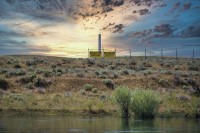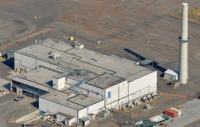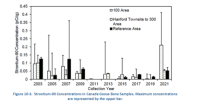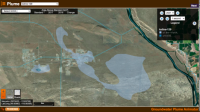What Did We Accomplish in 2022 and What is Coming Up in 2023
Hanford: Where are we today?
![[Image of 8 people waving from a fishing motorboat on the Hanford Reach during a Hanford Journey boat tour.]](/sites/default/files/styles/embed_half_s/public/2022-07/DSC02413.jpg?itok=b3gYO-q7)
In 2023, decades after ceasing plutonium production for nuclear weapons, the Hanford Nuclear Site remains the most toxic and radioactive place in the Western Hemisphere. For 50 miles, the Columbia River flows past decommissioned reactors, contaminated soil, radioactive seeps, and polluted groundwater. High-level waste tanks remain at risk for leaks. Highly radioactive capsules still sit in aging, water-filled basins at the Waste Encapsulation Storage Facility (WESF) despite years of warnings about the potential for a huge radioactive release if the basins were to fail. All the while, the federal government is struggling to meet legally-binding cleanup deadlines.
And yet, despite the damage caused by decades of nuclear weapons production, Hanford is much more than a wasteland. Since time immemorial, Tribal people have relied on the land, River, and resources at Hanford. Now, despite the vast, toxic, and radioactive legacy of decades of plutonium production, Hanford’s resources sustain the region—free-flowing water for salmon, drinking water for Richland, water for irrigation, and habitat for elk, sturgeon, eagles, rare plants and many other birds, fish, and wildlife.
Creative Action and Critical Decisions – How did the public influence clean up in 2022?
These are pivotal years for understanding and shaping the future of the Hanford Reach and the contaminated site that borders it. Soon, the U.S. Department of Energy (Energy) will make major decisions about how much pollution it intends to leave in tanks, soil, groundwater, and in reactor areas close to the Columbia. Washington’s Department of Ecology (Ecology), the Environmental Protection Agency (EPA), and Energy will conclude sweeping negotiations regarding how the federal government will meet its cleanup obligations. Energy hopes to begin turning tank waste into glass, a long-promised solution for immobilizing some of Hanford’s most dangerous waste stored in aging, leak-prone, underground tanks.
Anticipating these challenging decisions and events, thousands of people demonstrated during 2022 an enduring, growing demand for a Hanford cleanup that protects people and the Columbia River. Here are some of the major milestones during the last year.
- In June, nearly 200 people attended the Hanford Journey Event, touring the Hanford Reach on boat and learning about the cleanup by foot from the White Bluffs. The event was co-sponsored by Yakama Nation’s Environmental Restoration and Waste Management Program (ERWM). Davis Washines, Government Relations Liaison for Yakama Nation, said
We come here today to recognize the work on what you call ‘Hanford Nuclear Reservation.’ There’s a history here to this area and people. This is an important place we have a duty and a responsibility to protect because all the children here represent the future. The elders are told, ‘We don’t own this, it doesn’t belong to us—it belongs to them, even the ones not even born yet.’ We have a responsibility to teach them, their generation will have the ability to carry on. Especially our oral traditions that explain our way of life.
- This summer, Columbia Riverkeeper released “Water’s Walk Through Hanford,” an interactive, accessible perspective on Hanford, available in both English and Spanish. In the story, author Lisa Muñoz and illustrator Try Cheatham depict Hanford from the point of view of a drop of water finding its way to the Big River amid leaking tanks and polluted aquifers. In the story, we learn about the importance of protecting the water and how the water protects us: shielding radiation, diluting pollution, and cooling dangerous capsules.
- Thousands of people took action by submitting comments calling on the federal government to invest more to prevent high-level waste from leaking into Hanford’s soil. We joined with a coalition of business, government, and public interest groups requesting Congress to allocate more funds for cleanup. In 2022, Congress responded by increasing Hanford’s budget rather than cutting it. Additionally, we pushed back on plans to rewrite the definition of high-level waste. Thus far, Energy has balked at attempting to use a new definition of high-level waste at Hanford that would give the federal government a free hand to leave high-level waste near the Columbia River.
Snapshots of Cleanup Challenges- What will we see in 2023?

In 2023, despite some progress in cleanup efforts, the Columbia River still faces profound threats.
Groundwater Pollution Threats
From the River’s shoreline to the Central Plateau miles away, dozens of square miles of shrub-steppe habitat sit atop groundwater pollution that exceeds standards for safe use. The federal government prohibits access to Hanford’s shoreline because of radioactive and toxic contamination.
This map and chart depict pollution data from one of the hundreds of monitoring wells near the Columbia River.
The zigzagging black line on the far right shows radioactive, cancer-causing strontium-90 persisting at extraordinarily high levels near the cocooned N Reactor, very close to the Columbia River.
In August 2022, strontium-90 concentrations spiked to over 2,000 times the drinking water standard. Water seeping from the shoreline also exceeds drinking water standards.1
The figure below from Energy’s 2021 Hanford Site Monitoring Report, shows how, in the 100 Area (where the N Reactor is located), wildlife sometimes register elevated levels of strontium-90. Strontium-90 can collect in the bones of Canada geese, for instance, because strontium’s chemical behavior is similar to calcium.
The tallest bar on the far right shows one goose sampled in 2021 with bones more radioactive than any other goose tested since 2003.
Viewing the problem another way, an illustration by Try Cheatham helps visualize some of the ways that pollution has leaked into groundwater from trenches, tanks, and buildings.

As the water moves, it can carry contamination with it. Most of the groundwater is destined for the Columbia River. To lessen Hanford’s impact on the River, Energy extracts groundwater, treats it, and removes contaminants before re-releasing the water into the ground.
These pump and treat efforts remain an essential aspect of Energy’s groundwater cleanup for 2023. However, pump and treat systems cannot fully capture Hanford’s groundwater pollution. Some contaminants, such as iodine-129, which has a half-life of almost 16 million years, are not treated at all and spread through dozens of square miles of the site. The light-blue colored area below represents I-129 exceeding pollution standards in groundwater, spreading towards the Columbia on the right.
In other places, Energy attempts to immobilize pollution in the soil. In the 300 Area (just upstream from Richland), uranium levels reached almost 50 times the drinking water standard. High uranium levels persist despite Energy’s attempt to immobilize uranium by treating the soil with a chemical solution.
Also in the 300 Area, the image below shows the 324 Building, a facility that sits atop lethally radioactive soil. Workers discovered a new area of extremely intense soil contamination in 2022, posing a major challenge for worker safety and cleanup just a few hundred yards from the Columbia River.
Cleanup must do more to protect groundwater, the river, and people.

Most people find the news about Hanford’s ongoing contamination problems disturbing. Yet, the problem would be immeasurably worse without the activism and action of people across the Northwest who demand accountability, press elected officials and agency leaders for results, and stand in solidarity with the Tribal people who have lived at Hanford and relied on its resources since time immemorial. The determination of generations of Tribal leaders, public interest groups, government officials, and cleanup workers has, in fact, reduced contamination reaching the Columbia River.
But how far will Energy go in addressing the unresolved problems at Hanford? Will the government attempt to shortcut the cleanup, opting to cut costs rather than protect the River and people who depend on it? We plan to press the agencies to protect people and the environment as they develop upcoming decisions regarding cleanup for nuclear reactor areas close to the River, such as the K area and N Area. Energy plans to release new studies and plans to determine how much contamination the government will remove from reactor areas. Although Energy touts River Corridor cleanup as “largely complete,” data and the images above tell a much different story.
Already in 2023, Energy is asking the public for input on how it should treat and immobilize some of the most dangerous, toxic, radioactive waste in Hanford’s high-level waste tanks. The “high-level” portion of Hanford’s tank waste contains a huge amount of radioactivity along with chemically hazardous materials that pose intense worker safety and environmental risks.
Unless addressed and mobilized, the high-level waste would leach into Hanford’s soil, progress into groundwater, and ultimately find its way to the Columbia River, the lifeblood of the Northwest.
In the long cleanup journey ahead, we must be the ones to hold the U.S. government accountable.
What we can do in 2023
These are a few bottom lines we will work to hold in 2023:
- Energy must address pollution near the Columbia in a way that protects human health and the environment. Energy’s cleanup plans shouldn’t permanently restrict access to large tracts of the River Corridor. Instead, Energy’s cleanup plans should return the Columbia River to unrestricted use, as much as possible, and work to comply with the federal government's obligations to honor Tribes’ Treaty-reserved rights to use Hanford. Cancer-causing radioactive and toxic contamination levels remain very high in some areas close to the River. Energy should avoid downplaying these ongoing problems as it nears final cleanup plans near the K Reactor, N Reactor, and in the 300 Area.
- Energy should treat high-level waste as the law requires. This means Energy must treat, immobilize, and remove high-level waste from Hanford. Energy’s proposals to redefine high-level waste, abandon high-level waste in tanks, or use shortcuts that limit short-term costs (such as using unproven grout rather than vitrifying waste into a glass) would prolong and exacerbate risks to groundwater.
- Energy and Ecology should move swiftly to implement and accelerate efforts to prevent future tank leaks, respond to leaks where they occur, and address tanks that have already failed. While successful startup of the Waste Treatment Plant can help in this effort, this may be more than one year away. Washington must hold Energy accountable for the threat posed by high-level waste in decades-old tanks.
- Energy should move as quickly as possible to remove highly radioactive cesium and strontium capsules from the Waste Encapsulation Storage Facility (WESF), the highest-risk facility at the Hanford Site. WESF contains tens of millions of curies of radioactive material, almost one-third of all the radioactivity in Hanford’s waste sites. If aging water-filled basins were to fail, cesium and strontium could be released into the environment. WESF should be one of the highest priorities at Hanford.
Take Action

Your comments play a significant role in holding the government accountable. Take action today by signing our petition that calls on Energy, Ecology, and the EPA to pursue thorough cleanup near the Columbia River.
Stay tuned in coming weeks as we provide more information about Energy’s plans for high-level waste at Hanford. Depending on their approach, decades of cleanup efforts could lead to shortcuts, sub-par results, and thousands of years of pollution risks to the Columbia River.
Cleanup will be a marathon, not a sprint. We must continue the journey.
- Hanford Site Environmental Report for Calendar Year 2021. See also Hanford Site Groundwater Report for Calendar Year 2021. See also PHOENIX database, data for groundwater well 199-N-67.






